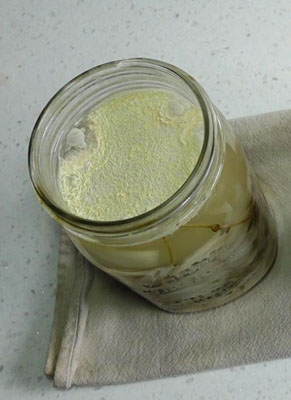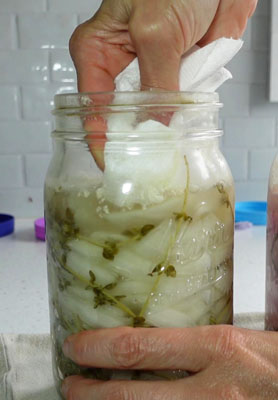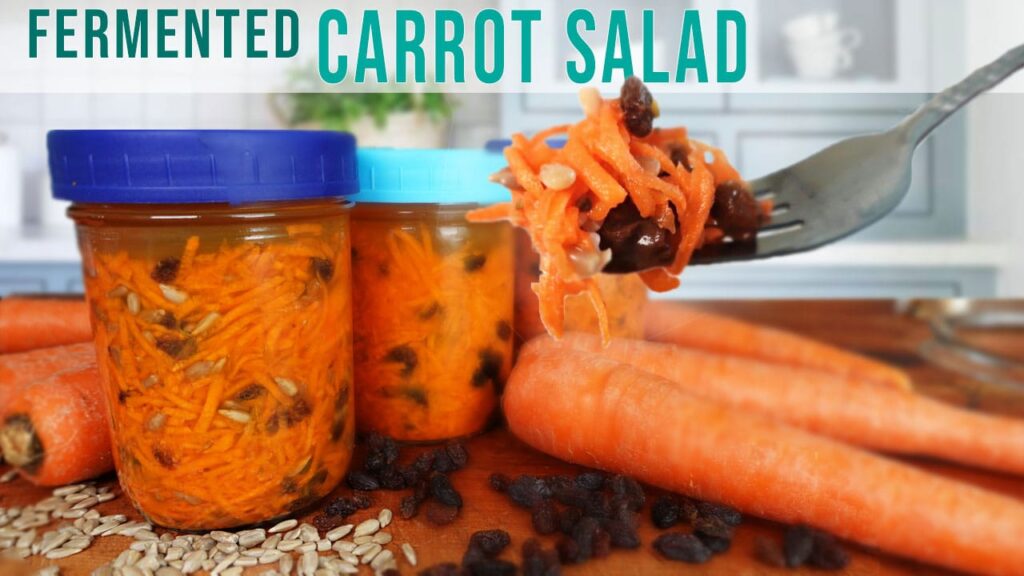
This “Kahm Yeast” post contains affiliate links. Please read my affiliate disclosure.
Identifying Kahm Yeast: What Is It?
Kahm yeast is a mixture of different wild yeasts naturally present in the air. They settle on top of a fermentation and present themself as a thin, white to cream-colored layer. Any bubbles the film may contain are result of fermentation gasses releasing from the food below and becoming trapped.
Often times kahm yeast is mistaken for mold. But unlike mold, it is harmless and won’t spoil the fermentation nor cause it to be unsafe to eat. However, it can make the appearance of the final product look unappealing.


Why Does Kahm Yeast Form?
The yeast genera which form these films include Debaryomyces, Mycoderma and Pichia.1 Their development on fermentations is closely linked to two factors: oxygen exposure and food type. Therefore, when oxygen is present, such as the surface area of a fermentation, kahm yeast has the opportunity to develop. It also has a tendency to form on vegetable ferments that are high in natural sugars such as carrots, beets, onions and red cabbage (not green).
Additionally, most vinegars originate from fruit such as apples and grapes. Since fruits are high in natural sugars, they’re an attractant for kahm yeast!
Prevention Solutions for Vegetable Ferments
#1 Oxygen Reduction
For vegetable ferments that are prone to kahm yeast, the key is to reduce the amount of oxygen present in the jar as much as possible.
To do so, fill the fermentation vessel up to the top of the jar with the brine, leaving only a 1/2 inch (1 cm) of headspace. Next, place a regular lid on the jar. From here the oxygen gap is much smaller than if the jar was not full. This alone can significantly reduce the amount of kahm yeast that could potentially form.

Filling a jar with brine of a corn salsa fermentation

The brine of this kale fermentation fills the jar, leaving only a 1/2 inch (1 cm) headspace.
#2 Specialty Fermentation Lid
Although a specialty fermentation lid is not mandatory when fermenting, it can further reduce the formative growth of kahm yeast beyond the “fill the jar up” method.
How do they work? A specialty fermentation lid has a one-way valve system built-in. It permits the fermentation gasses to escape, but does not allow oxygen to enter. As for the air already present inside the jar once the lid is put on, the fermentation gasses will push it up and out through the one-way valve.

Keep in mind, if there is a lot of headspace in the jar when the specialty lid is put on (due to the jar not being filled up) most likely the excess oxygen won’t be completely pushed up and out. Therefore some kahm yeast can still form on the fermentation surface. That’s why the ‘filling the jar up’ tactic should be done in conjunction with a specialty fermenting lid.
However, there is one type of specialty fermenting lid that includes an oxygen extraction pump. It works by sucking out the excess air from the jar right away instead of waiting on the fermentation gasses to push it out. This dramatically reduces the opportunity for kahm yeast and in many cases, completely eliminates it.

See The Lids In Action!
Watch my video below for demonstrations of the most common specialty lids on the market along with their kham yeast results. This includes a demonstration of the oxygen extracting pump!

Click the button below to browse my favorite specialty fermenting lids.
Prevention Solution for Vinegar Ferments
Vinegar fermentations are the opposite of vegetable fermentations when it comes to the presence of oxygen because vinegar making requires it whereas vegetable fermentation does not! This is because the probiotic microbes utilized for the vinegar making process (Acetobacter) are different from the microbes utilized in vegetable fermentation (Lactobacillus). Oxygen is mandatory for successful vinegar making, but unfortunately it encourages the development of surficial kahm yeast.
Daily Stirring
It is quite simple to stop the formation of kahm yeast on the vinegar by giving it a gentle stir on a daily basis. The stirring action disrupts the kahm yeast microbes settling on the vinegar surface, preventing them from forming that distinctive skin. Additionally, the Acetobacter bacteria responsible for the vinegar fermentation, love the aeration generated by the stirring which results in a better tasting vinegar!
Warning
Only give a daily stir to vinegar fermentations and not vegetable fermentations!
As mentioned above, the processes of vinegar and vegetable fermentation are not the same. They utilize different types of microbes and therefor require different procedures. Aerating a vegetable fermentation could prove disastrous whereas aerating a vinegar fermentation proves beneficial.
The Kahm Yeast Is Already There: How To Remove It
Only remove the kahm yeast at the end of a vegetable or vinegar fermentation rather than during. This is because it will immediately grow back the next day, except worse than before. Therefore, be patient and follow the kahm yeast removal steps below once the vegetable or vinegar fermentation has completed it’s process.
Removal of Kahm Yeast on Vegetable Fermentations: Step 1
With clean hands, reach in and remove the fermenting weight. A little kham yeast on the fingers is harmless and hands are washable, so do not fear contact!
The good news is, the weight brings out with it most of the kahm yeast. You can wash the weight as normal since the film easily rinses away.


Removal of Kahm Yeast on Vegetable Fermentations: Step 2
- Use a paper towel and dab the remaining kahm yeast surface specs. A few pieces left behind are harmless and should not be a concern.
- Next, wipe out any kahm yeast sticking to the inside of the jar.
- Do not retrun the weight and place a regular lid tightly on the jar (no need to continue using a specialty lid if you were).
- Transfer the vegetable fermentation to the refrigerator for long term storage. The cool temperatures of the refrigerator will retard further growth of kahm yeast.

Removal of Kahm Yeast on Vinegar Fermentations
If you didn’t give your vinegar fermentation a daily stir to prevent kahm yeast, no problem. At the end of the fermentation period, strain the vinegar through a fine mesh sieve. This removes the yeast film quickly & easily!
If any tiny kahm yeast pieces remain in the vinegar, do no fret because kahm yeast is harmless. It will not regrow after the straining & commencement of the active fermentation period.

Summing Up…
Understanding kahm yeast and its relationship to oxygen exposure is essential when it comes to the prevention of kahm yeast on fermentations.
By tailoring your approach based on the specific requirements of the fermentation process, whether anaerobic for vegetable ferments or aerobic for vinegar ferments, you can minimize the its development or eliminate it all together.
Experimenting with these techniques will help you not only achieve a delicious & probiotic rich fermented foods, but create a visually appealing ones as well!
Fermentation Funk Series
I have a series on my YouTube channel called, Fermentation Funk. I cover a variety of common fermenting situations that occasionally occur varying from slimy brine, brown layers and mold. Click here to browse the video playlist on my YouTube channel, Clean Food Living.

Citations
- Wikimedia Foundation. (2023, June 26). Kahm. Wikipedia. https://en.wikipedia.org/wiki/Kahm#:~:text=Kahm%20or%20Kahm%20yeast%20is,means%20dust%2C%20dirt%20or%20mould.










